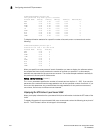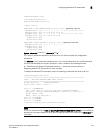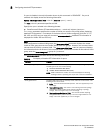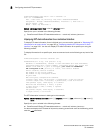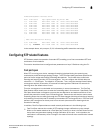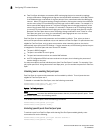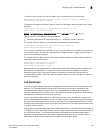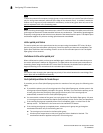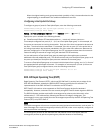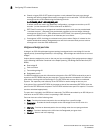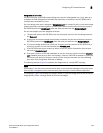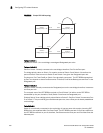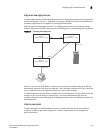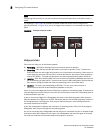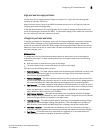
226 PowerConnect B-Series FCX Configuration Guide
53-1002266-01
Configuring STP related features
8
NOTE
To avoid the potential for temporary bridging loops, recommends that you use the Fast Uplink feature
only for wiring closet switches (switches at the edge of the network cloud). In addition, enable the
feature only on a group of ports intended for redundancy, so that at any given time only one of the
ports is expected to be in the forwarding state.
NOTE
When the wiring closet switch first comes up or when STP is first enabled, the uplink ports still must
go through the standard STP state transition without any acceleration. This behavior guards against
temporary routing loops as the switch tries to determine the states for all the ports. Fast Uplink Span
acceleration applies only when a working uplink becomes unavailable.
Active uplink port failure
The active uplink port is the port elected as the root port using the standard STP rules. All other
ports in the group are redundant uplink ports. If an active uplink port becomes unavailable, Fast
Uplink Span transitions the forwarding of traffic to one of the redundant ports in the Fast Uplink
Span group in four seconds.
Switchover to the active uplink port
When a failed active uplink port becomes available again, switchover from the redundant port to
the active uplink port is delayed by 30 seconds. The delay allows the remote port to transition to
forwarding mode using the standard STP rules. After 30 seconds, the blocked active uplink port
begins forwarding in four seconds and the redundant port is blocked.
NOTE
Use caution when changing the spanning tree priority. If the switch becomes the root bridge, Fast
Uplink Span will be disabled automatically.
Fast Uplink Span Rules for Trunk Groups
If you add a port to a Fast Uplink Span group that is a member of a trunk group, the following rules
apply:
• If you add the primary port of a trunk group to the Fast Uplink Span group, all other ports in the
trunk group are automatically included in the group. Similarly, if you remove the primary port in
a trunk group from the Fast Uplink Span group, the other ports in the trunk group are
automatically removed from the Fast Uplink Span group.
• You cannot add a subset of the ports in a trunk group to the Fast Uplink Span group. All ports
in a trunk group have the same Fast Uplink Span property, as they do for other port properties.
• If the working trunk group is partially down but not completely down, no switch-over to the
backup occurs. This behavior is the same as in the standard STP feature.
• If the working trunk group is completely down, a backup trunk group can go through an
accelerated transition only if the following are true:
• The trunk group is included in the fast uplink group.
• All other ports except those in this trunk group are either disabled or blocked. The
accelerated transition applies to all ports in this trunk group.



